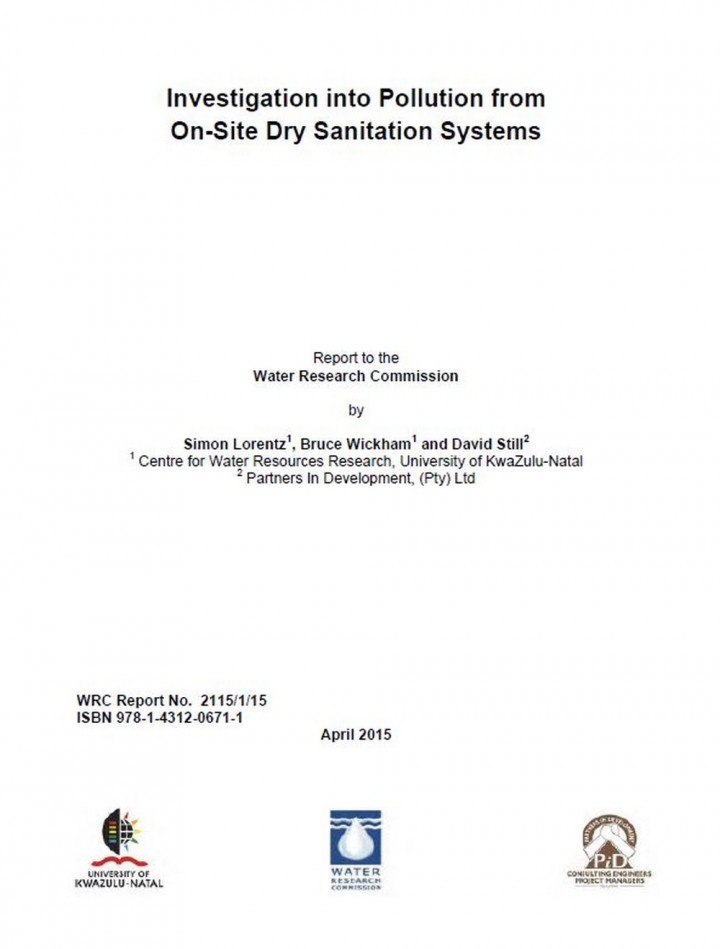Investigation into pollution from on-site dry sanitation systems
Lorentz, S., Wickham, B., Still, D. (2015)

Published in: 2015
Pages: 128
Publisher:
Report to the Water Research Commission, WRC Report No. 2115/1/15, University of KwaZuIu-Natal, Partners in Development, South Africa, ISBN 978-1-4312-0671-1
Author:
Lorentz, S., Wickham, B., Still, D.
Uploaded by:
SuSanA Admin
Partner profile:
common upload
4751 Views
77 Downloads
The impact of onsite sanitation on water resources has been the subject of much study with regard to conventional septic tanks and soak-aways. However, research of impacts from rural and peri-urban communities using pit latrines, particularly in underdeveloped countries, has been unconvincing. With the increase in the extension of sanitation services provided by the South African Government anticipated to result in the establishment of some 6 million onsite dry sanitation systems, there is a need to assess the overall health and pollution impacts of these systems. The scale of application of these systems, in concert with highly variable climatic conditions and a range of geological formations and soilscapes, warrant a scientific assessment of the pollution potential of dry sanitation systems so that they can be properly sited, designed, installed, monitored and maintained.
The objectives of this study are therefore to:
• Develop an understanding of the conditions and processes that may lead to Migration of pollutants from onsite dry sanitation systems so that guidelines to minimise the impact of onsite sanitation to the water resources in South Africa may be developed;
• Identify techniques, methods and models used in evaluating groundwater Pollution from onsite sanitation; and to
• Derive the necessary knowledge for input to best practice guidelines for Monitoring and minimising the Impacts from onsite dry sanitation.
The study comprises a comprehensive overview of current research and systematic observation of selected sites, comprising a range of geologies and sanitation types in order to derive an understanding of the effluent migration sources, pathways and mechanisms to inform the development of best practice guidelines.
State-of-the-art:
Many studies have been conducted on the widespread use of pit latrines. Regrettably, no consistent methodology has been used to monitor or report the extent of nutrient or pathogen movement. Very often, the studies comprise monitoring of local boreholes down gradient of informal or peri-urban developments. Several case studies report incidences of nutrient and pathogen contamination as a result of on-site sanitation contaminating water resources.
Elevated concentrations of nutrients and pathogens have been observed between 20 and 90 m from latrines. Studies also claim that observations from boreholes some 900 m downstream of developments where pit latrines are used have shown increases in pathogen abundance. Only one study warns that the rapid lateral subsurface flow from extreme events may move nutrients and pathogens from pit latrines, but no observations are evident in the literature.
Methodology:
Four sites on two geologies were established in this study. A transect of four VIP latrines were monitored on a hillslope and an associated background site was coupled with this transect. Three other sites were established to monitor individual pour flush latrines. Observations comprised sampling of water from nearby streams, subsurface water from shallow piezometers and infiltrating soil water. The piezometers were established at selected intervals downslope of the latrines as well as at background stations upslope of the latrine. Infiltrated water was monitored through wetting front detectors. In addition geophysical and hydropedological surveys were conducted at each site in order to define the flow pathways and connectivity of the hillslopes. A nearby weather station was used to record meteorological data, while local rain gauges were established at the sites. Pit latrine contents were sampled on two occasions and analysed for nutrients and pathogens. Analyses on the water samples included stable isotopes of water to aid in the definition of connectivity of flow pathways, nitrate, ammonium, phosphate and a selection of cations and anions.
Conclusions and Recommendations:
In comparison to previous studies, nitrate movement does not appear to be as significant at the KwaZulu-Natal study sites compared to other studies. However they are consistent with each other in terms of greatest mobility during periods of high rainfall. The same can be said for the mobility of E. coli. However at the Slangspruit site, a distinct E. coli plume extended to 26 m, whereas the nitrate was only evident up to 3 m. At this site where the water table was consistently high (i.e.
Bibliographic information
Lorentz, S., Wickham, B., Still, D. (2015). Investigation into pollution from on-site dry sanitation systems. Report to the Water Research Commission, WRC Report No. 2115/1/15, University of KwaZuIu-Natal, Partners in Development, South Africa, ISBN 978-1-4312-0671-1
Filter tags
English Faecal sludge treatment processes Groundwater protection (WG11) Rural Sub-Saharan Africa















